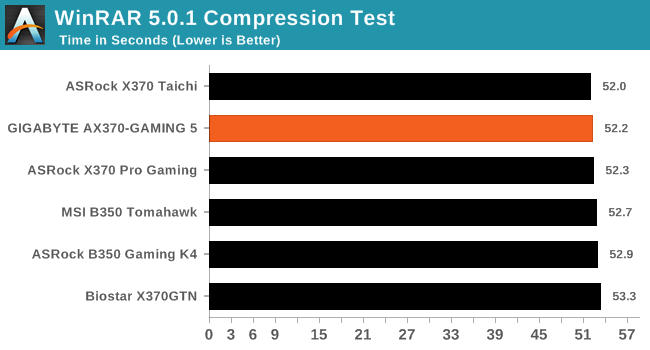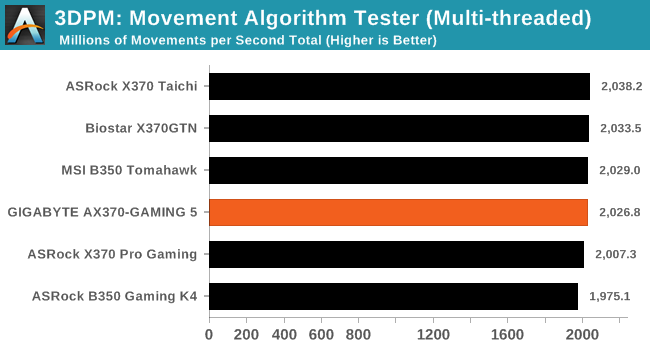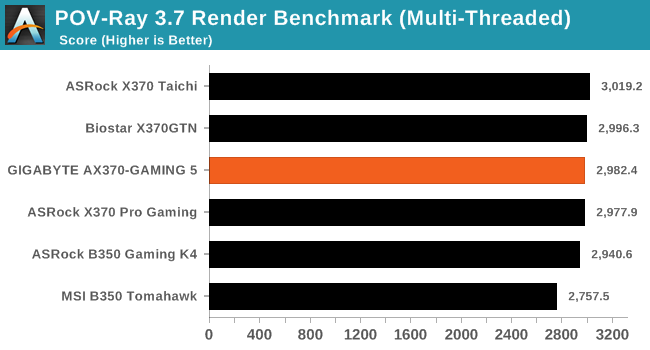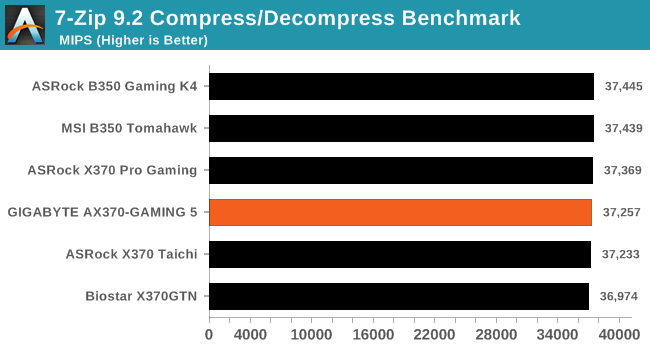The GIGABYTE Aorus AX370-Gaming 5 Review: Dual Audio Codecs
by Gavin Bonshor on November 14, 2017 12:30 PM ESTCPU Performance, Short Form
For our motherboard reviews, we use our short form testing method. These tests usually focus on if a motherboard is using MultiCore Turbo (the feature used to have maximum turbo on at all times, giving a frequency advantage), or if there are slight gains to be had from tweaking the firmware. We put the memory settings at the CPU manufacturers suggested frequency, making it very easy to see which motherboards have MCT enabled by default.
Video Conversion – Handbrake v1.0.2: link
Handbrake is a media conversion tool that was initially designed to help DVD ISOs and Video CDs into more common video formats. For HandBrake, we take two videos and convert them to x264 format in an MP4 container: a 2h20 640x266 DVD rip and a 10min double UHD 3840x4320 animation short. We also take the third video and transcode it to HEVC. Results are given in terms of the frames per second processed, and HandBrake uses as many threads as possible.



Compression – WinRAR 5.4: link
Our WinRAR test from 2013 is updated to the latest version of WinRAR at the start of 2017. We compress a set of 2867 files across 320 folders totaling 1.52 GB in size – 95% of these files are small typical website files, and the rest (90% of the size) are small 30 second 720p videos.

Point Calculations – 3D Movement Algorithm Test v2.1: link
3DPM is a self-penned benchmark, taking basic 3D movement algorithms used in Brownian Motion simulations and testing them for speed. High floating point performance, MHz and IPC wins in the single thread version, whereas the multithread version has to handle the threads and loves more cores. For a brief explanation of the platform agnostic coding behind this benchmark, see my forum post here. We are using the latest version of 3DPM, which has a significant number of tweaks over the original version to avoid issues with cache management and speeding up some of the algorithms.

Rendering – POV-Ray 3.7.1b4: link
The Persistence of Vision Ray Tracer, or POV-Ray, is a freeware package for as the name suggests, ray tracing. It is a pure renderer, rather than modeling software, but the latest beta version contains a handy benchmark for stressing all processing threads on a platform. We have been using this test in motherboard reviews to test memory stability at various CPU speeds to good effect – if it passes the test, the IMC in the CPU is stable for a given CPU speed. As a CPU test, it runs for approximately 2-3 minutes on high end platforms.

Synthetic – 7-Zip 9.2: link
As an open source compression tool, 7-Zip is a popular tool for making sets of files easier to handle and transfer. The software offers up its own benchmark, to which we report the result.











34 Comments
View All Comments
Samus - Wednesday, November 15, 2017 - link
True, but the problem is most of the DAC's have a lower overall quality than many high end onboard DAC's. Especially wireless headphones. Until I found the SteelSeries H (Now the Siberia I guess...) I had pretty much given up finding wireless headphones with a decent DAC.PeachNCream - Tuesday, November 14, 2017 - link
Killer NIC... *sad panda*Flunk - Tuesday, November 14, 2017 - link
Only an issue if you want two Ethernet ports, there is also an Intel NIC on there.wolrah - Tuesday, November 14, 2017 - link
@Flunk that doesn't excuse it, that makes it worse. They clearly understand that Intel NICs are better, but they only half-assed it. Killer is gimmicky garbage. It needs to go away.The only non-Intel network card I want to see on a motherboard is one of the NBaseT products, and only because Intel doesn't yet make one.
DanNeely - Wednesday, November 15, 2017 - link
No, it means they clearly understand the market. Of the people who care about the nic brand, half have drank killer's koolaid and know it makes them game better, and half know that intel's the way to go because their drivers are much less garbage than the competition. This lets them supply both of the main halves of the care about nic brand market. The group of people who care about nic brand and need 2 of them is much smaller; losing them and/or sending them to a different model in the lineup isn't a major loss.PeachNCream - Thursday, November 16, 2017 - link
Does Qualcomm still own the Killer NIC brand? I thought that was their product operating under a subsidiary.nismotigerwvu - Tuesday, November 14, 2017 - link
There's a typo on your conclusions page. It should read "gigabit ethernet" not "gigabyte ethernet".Dr. Swag - Tuesday, November 14, 2017 - link
Could you guys add some more in depth vrm stuff into the mix? Like current capabilites, vrm temp measurements, etc. A lot of AM4 boards have sub par VRMs that don't have proper temp protections and stuff, so it would be really nice if you guys could add some stuff that looks into this sort of stuff.Horza - Tuesday, November 14, 2017 - link
The VRM information is incorrect as far as I know. It's running in 6+2 mode with, as you said, doublers on the SOC VRM so it's 6+(2x2) not 8+2.Cooe - Saturday, March 24, 2018 - link
This is correct. The flagship K7 also uses the exact same 6+(2x2) VRM setup (in addition to everything else aside from it's inclusion of a external BCLK generator & additional LED strip on the I/O shield).